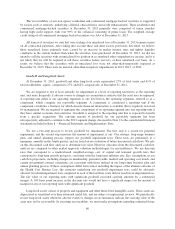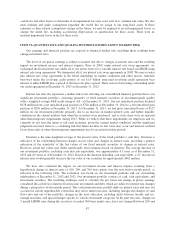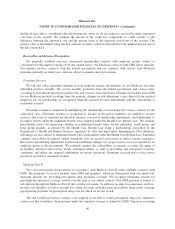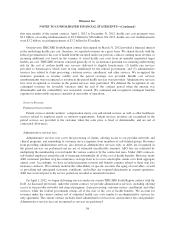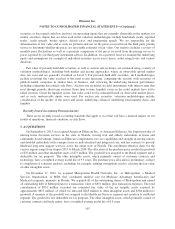Humana 2013 Annual Report Download - page 105
Download and view the complete annual report
Please find page 105 of the 2013 Humana annual report below. You can navigate through the pages in the report by either clicking on the pages listed below, or by using the keyword search tool below to find specific information within the annual report.Humana Inc.
NOTES TO CONSOLIDATED FINANCIAL STATEMENTS—(Continued)
securities, and the valuation and related impairment recognition of long-lived assets, including goodwill. These
estimates are based on knowledge of current events and anticipated future events, and accordingly, actual results
may ultimately differ materially from those estimates.
Business Segment Reclassifications
On January 1, 2013, we reclassified certain of our businesses to correspond with internal management
reporting changes and renamed our Health and Well-Being Services segment as Healthcare Services. Our
Employer Group segment now includes our health and wellness businesses, including HumanaVitality and
Lifesynch’s employee assistance programs, which had historically been reported in our Healthcare Services
segment. The Retail segment now includes our contract with the Centers for Medicare and Medicaid Services, or
CMS, to administer the Limited Income Newly Eligible Transition, or LI-NET, prescription drug plan program
as well as our state-based contracts for Medicaid members, both of which had historically been reported in our
Other Businesses category. Prior period segment financial information has been recast to conform to the 2013
presentation. See Note 16 for segment financial information.
Cash and Cash Equivalents
Cash and cash equivalents include cash, time deposits, money market funds, commercial paper, other money
market instruments, and certain U.S. Government securities with an original maturity of three months or less.
Carrying value approximates fair value due to the short-term maturity of the investments.
Investment Securities
Investment securities, which consist entirely of debt securities, have been categorized as available for sale
and, as a result, are stated at fair value. Investment securities available for current operations are classified as
current assets. Investment securities available for our long-term insurance products and professional liability
funding requirements, as well as restricted statutory deposits, are classified as long-term assets. For the purpose
of determining gross realized gains and losses, which are included as a component of investment income in the
consolidated statements of income, the cost of investment securities sold is based upon specific identification.
Unrealized holding gains and losses, net of applicable deferred taxes, are included as a component of
stockholders’ equity and comprehensive income until realized from a sale or other-than-temporary impairment.
Under the other-than-temporary impairment model for debt securities held, we recognize an impairment loss
in income in an amount equal to the full difference between the amortized cost basis and the fair value when we
have the intent to sell the debt security or it is more likely than not we will be required to sell the debt security
before recovery of our amortized cost basis. However, if we do not intend to sell the debt security, we evaluate
the expected cash flows to be received as compared to amortized cost and determine if a credit loss has occurred.
In the event of a credit loss, only the amount of the impairment associated with the credit loss is recognized
currently in income with the remainder of the loss recognized in other comprehensive income.
When we do not intend to sell a security in an unrealized loss position, potential other-than-temporary
impairment is considered using a variety of factors, including the length of time and extent to which the fair
value has been less than cost; adverse conditions specifically related to the industry, geographic area or financial
condition of the issuer or underlying collateral of a security; payment structure of the security; changes in credit
rating of the security by the rating agencies; the volatility of the fair value changes; and changes in fair value of
the security after the balance sheet date. For debt securities, we take into account expectations of relevant market
and economic data. For example, with respect to mortgage and asset-backed securities, such data includes
underlying loan level data and structural features such as seniority and other forms of credit enhancements. A
95



